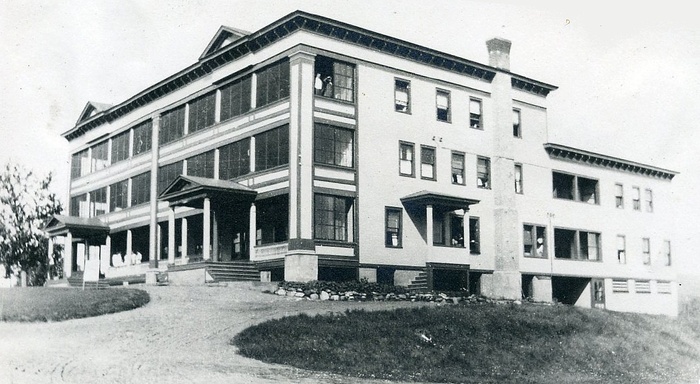 Rainbow Lake Sanatorium, 1910-1913
Rainbow Lake Sanatorium, 1910-1913
Courtesy of the Adirondack Experience Patients, Rainbow Lake Sanitorium, 1913
Patients, Rainbow Lake Sanitorium, 1913
Courtesy of the Adirondack Experience The Rainbow Sanatorium, front view, c. 1925
The Rainbow Sanatorium, front view, c. 1925 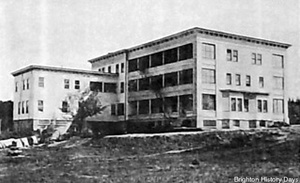 The Rainbow Sanatorium, rear view, c. 1925
The Rainbow Sanatorium, rear view, c. 1925 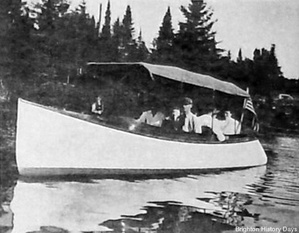 The Sanatorium motor boat, 1921
The Sanatorium motor boat, 1921 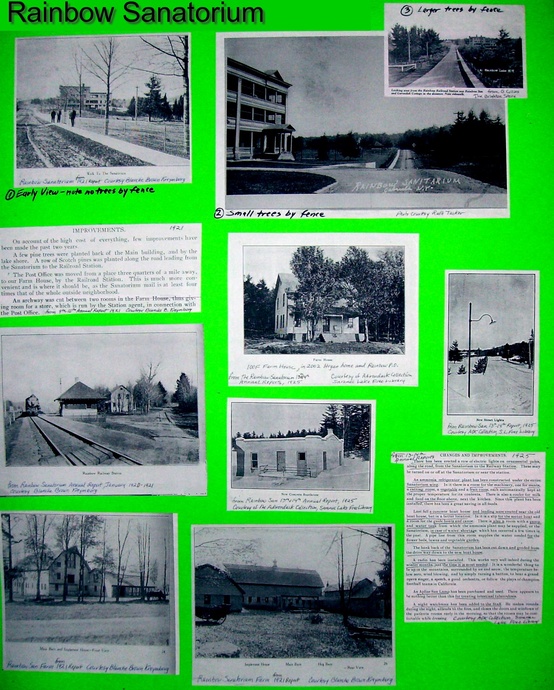 "Rainbow Sanitorium Continued" by Pat and Tom Willis, photo of display taken 2/2009. Click on the image to enlarge the display.
"Rainbow Sanitorium Continued" by Pat and Tom Willis, photo of display taken 2/2009. Click on the image to enlarge the display. 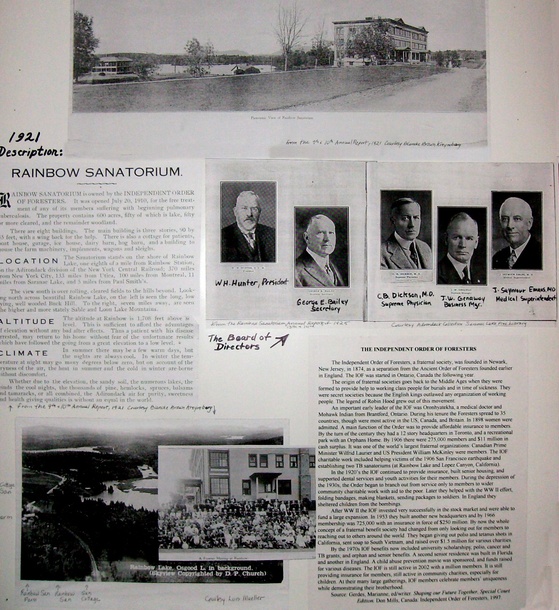 "Rainbow Sanitorium" by Pat and Tom Willis, photo of display taken 2/2009. Click on the image to enlarge the display. The Rainbow Sanatorium was established by the Independent Order of Foresters on Rainbow Lake for the free treatment of tuberculosis for members of the organization. It opened on July 20, 1910 on 600 acres of the Rainbow Inn that the Foresters had purchased. There were eight buildings in all, including the original Inn. The main building was 90 by 45 feet, equipped with steam heat and electric lighting; it was an eighth of a mile from the New York Central's Rainbow Lake Station. There were nine-foot deep porches running the length of three sides of the building. The property included a dairy barn, hog barn, ice house, and a carriage house that also housed farm equipment.
"Rainbow Sanitorium" by Pat and Tom Willis, photo of display taken 2/2009. Click on the image to enlarge the display. The Rainbow Sanatorium was established by the Independent Order of Foresters on Rainbow Lake for the free treatment of tuberculosis for members of the organization. It opened on July 20, 1910 on 600 acres of the Rainbow Inn that the Foresters had purchased. There were eight buildings in all, including the original Inn. The main building was 90 by 45 feet, equipped with steam heat and electric lighting; it was an eighth of a mile from the New York Central's Rainbow Lake Station. There were nine-foot deep porches running the length of three sides of the building. The property included a dairy barn, hog barn, ice house, and a carriage house that also housed farm equipment.
After World War I, having a shortage of member patients, they accepted as many as 65 tubercular veterans as patients. When they had been in operation for ten years, a report showed that they had admitted 642 patients, 102 the first year, and fewer than seventy in succeeding years until 1919 and 1920, when 192 were admitted.
In 1930, they decided to close the institution, and the remaining patients were moved to the Forester's Sanatorium in California. The land was divided among several purchasers, and the sanatorium and the old Inn were razed.
Source: The Brighton Story
Malone Farmer, February 9, 1910
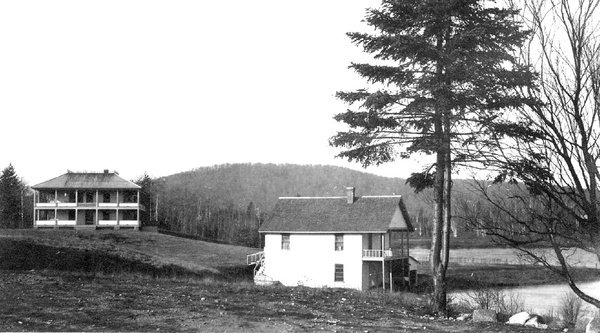 Independent Order of Foresters Cottage and Boathouse
Independent Order of Foresters Cottage and Boathouse
Courtesy of the Adirondack Experience
Arrangements for the transfer of the Rainbow Inn property at Rainbow Lake to The Foresters have been completed and the papers will passed this week. The purchase includes the hotel, its furnishings and all the land which Mr. Barnard had left after his auction sale of lots last summer—between five and six hundred acres, some of which is well timbered. Saturday a party of officers of the order visited and inspected the property to determine what changes and improvements would be necessary in the present structure to adapt it to the purposes of a sanatorium. These improvements will probably include a heating plant, lighting and sewerage systems, hardwood floors in some of the rooms, etc., and it is now expected that the structure will be opened for patients about the first of May. The physician appointed to look after the patients will also act as superintendent. Dr. Whipple, of Malone, who has had considerable actual experience along this line, has applied for the place and his chances are believed to be unusually—good for receiving the appointment. The party which made the trip to Rainbow Saturday comprised the following:—Supreme Physician Millman, of Toronto; High Chief Ranger Kinney, of Gouveneur; Dr. M. J. Davies, of Utica, Past High Chief Ranger; Dr. W. E. Duell, of Canastota, High Physician; High Chief Ranger Higgins, of Syracuse; High Secretary Bailey, of Antwerp: Dr. Kustle, of Huntingdon, High Vice-Chief Ranger of the Province of Quebec; High Counselor Genaway and Dr. George H. Oliver, of Malone. The price paid for the Rainbow Inn property is $20,000 for which Mr. Genaway already has the check. The main hotel building has 30 sleeping rooms and there is an annex, with 20 rooms. The are stables for 25 head of cattle and [???] horses. It is proposed to spend $50,000 on the property before the 15th of May.
MEDICAL REPORT - 1921
Since the Sanatorium opened 611 patients have been treated and discharged. Of these, 3 were extra-pulmonary and 14 non-tubercular, leaving 594 cases of pulmonary tuberculosis.
Of these, nearly 100 per cent of the incipient cases were cured, had their disease arrested, or were improved. Only one case out of the 120 failed to improve, and this was distinctly the patient's fault.
About 75 per cent of the moderately advanced cases were benefited more or less permanently.
Of the far advanced cases 50 per cent received benefit, mostly temporary, while the other 50 per cent became steadily worse.
With these facts before us, we see how absolutely necessary it is to recognize the disease early and begin treatment at once.
The reason for failure lies with both patient and physician. The one does not pay attention to the symptoms and go to the physician at once, and often the physician does not recognize the early symptoms. In either case, he patient suffers, and may have a long fight to win, or may in the end lose his life.
As an aid, it may be well to state the early symptoms noted.
Our records show 56.41 began "catarrhal" with cough or expectoration or both; 21.00 per cent "inisidiously" with indigestion, loss of weight and strength, irritability, slight afternoon fever, rapid pulse, night sweats, etc.; 10.57 per cent began with pleurisy; and 6.25 per cent raised blood; 5.44 per cent followed pneumonia; .33 per cent began in the intestinal tract.
Thus, about 78.67 per cent of the cases began with pleurisy, pneumonia, raising blood, or prolonged bronchitis; all symptoms pointing directly the lungs. The other 21.33 per cent developed it while the patient was in a "run down" condition, which condition was caused by beginning Tuberculosis, or possibly allowed it to develop.
Tuberculosis is a rich man's disease, but the poor man has it. It is a disease which cannot be fought off by will power and physical activity.
DR. J. SEYMOUR EMANS
Original Text by Pat and Tom Willis
Rainbow Sanatorium was by no means the complete plant it became at the time Dr. Seymour Emans became its head a short time after it was opened. Dr. Emans, who was practicing in New York City, first came to Saranac Lake because of ill health. He had reached a fair state of health again when asked by high officials of the Independent Order of Foresters to become the medical superintendent at their new sanatorium that they were beginning to send patients to from all sections of the United States. Dr. Emans had been recommended to the post by Dr. Edward R. Baldwin and other Saranac Lake physicians.
Anxious to return to his practice in the metropolis, Dr. Emans hesitated about accepting the offer but at last consented to serve four months, during which he hoped to put the new venture on a smooth working basis. Because he became greatly interested in the work, he remained for the duration of the sanatorium's existence. He devoted his entire time making the sanatorium one of the most notable in the country. Countless improvements were made under his direction. The buildings, grounds, farm, roads were all made to give better service to the end that patients, medical staff and all employees might enjoy a full measure of happiness and comfort. Those who had long been familiar with conditions at the Rainbow Sanatorium asserted that it had accomplished a worthy work under the leadership of Dr. Emans. They called attention to its record of more than a thousand patients, scores of whom have received a new lease of life at Rainbow Lake.
Besides his work for the sanatorium, Dr. Emans also served the surrounding community. The only physician for miles around, Dr. Emans was always available, despite not being in active practice. The night was never too dark or the cold too bitter for him to answer a call for aid, from far or near. By all the folk of the region he was regarded as a kind friend as well as a skilled physician. Dr. Emans lived out the last years of his life in a small home in Gabriels which is still to be seen on the Rainbow-Onchiota Road and is now the home of Pauline Meagher.
This information from an Adirondack Daily Enterprise article dated August 28, 1930.
Melvin Yell
Melvin Yell, who grew up on the Jones Pond Road and now lives in Saranac Lake, is 83 years of age and remembers working at the Rainbow Sanatorium as a teenager. His job was washing dishes and sometimes milking the cows. He remembers with a smile that he was required to wear a white coat while milking cows in the barn. His grandmother Corrie Yell also worked at the San as cook. She was married at the age of 12 and had 4 or 5 children. Melvin remembers her as a hard working lady.
Melvin remembers being treated by Dr. Emans. When he was about 5 or 6 year old, he burned his hand when a firecracker exploded in it. He was told to soak his hand in kerosene. This took all the sting out of the burn and his hand healed up nicely. Another time Melvin developed pneumonia. They put cow manure on his chest which Melvin says drew the disease right out and he could go right back to school. On another occasion, Melvin cut his finger very badly. This time the treatment was to put pine pitch and tar on it and bandage it up with cheesecloth and shellac. This healed up in one week.
Melvin remembers the Rainbow Sanatorium as “a good place to work. Nobody bothered anybody.”
Source: Interview with Melvin Yell 5/7/02
Pauline Rochester Meagher
Pauline Rochester Meagher grew up in Rainbow Lake in a large house on the Rainbow-Onchiota Road. Before she and her twin brother Paul were born in 1920, her parents John Rochester and Jenny Boswell Rochester worked at Rainbow San, he as caretaker and she as cook. Pauline remembers the San as a “big, beautiful building,” and that “it was a busy place.” She remembers Dr. Emans as “a lovely man.” He lived in what is now her bungalow style home (built by Benjamin A. Muncil) and actually passed away there.
Source: Interview with Pauline Meagher 5/9/02
Alice Schrader Warner
Alice Schrader Warner grew up in Rainbow Lake. She remembers receiving the smallpox vaccine at the Rainbow San. Matt Knudsen had come to the San to cure for bronchiectasis caused by being gassed in World War I. He stayed and went to work for the Frank Wardner Farm resort near the Schraders. He also became the Town Justice for the Town of Brighton. Alice remembers Billy Williams, who had been an orphan, was employed by the San later on as caretaker. She remembers that he kept the place immaculate and was so saddened when it closed that it affected his mind. After the building was torn down, he lived with the Rochester for a time. Source: from Alice Schrader Warner, 2/28/02
Rainbow Sanatorium Closes
By 1930 the Rainbow Sanatorium was experiencing a decline in patient applications and a rise in costs, as were other sanatoriums. It was decided that patients could be cared for elsewhere (the IOF had another san in California) and that Rainbow San would be closed. The property was eventually sold to William Hogan (farm), Douglas Martin (became the Vosburgh subdivision), Harry Hull (Noel Prellwitz now owns some), and Carl Anderson. The boathouse was moved to make the Higgins residence. The main building was eventually torn down as a fire hazard and trees, now quite tall, were planted on the site. Source: from Geraldine Collins, The Brighton Story, and Alice Warner
Independent Order of Foresters
The Independent Order of Foresters, a fraternal society, was founded in Newark, New Jersey, in 1874, as a separation from the Ancient Order of Foresters founded earlier in England. The IOF was started in Ontario, Canada the following year.
The origin of fraternal societies goes back to the Middle Ages when they were formed to provide help to working class people for burials and in time of sickness. They were secret societies because the English kings outlawed any organization of working people. The legend of Robin Hood grew out of this movement.
An important early leader of the IOF was Oronhyatekha, a medical doctor and Mohawk Indian from Brantford, Ontario. During his tenure the Foresters spread to 35 countries, though were most active in the US, Canada, and Britain. In 1898 women were admitted. A main function of the Order was to provide affordable insurance to members. By the turn of the century they had a 12 story headquarters in Toronto, and a recreational park with an Orphans Home. By 1906 there were 275,000 members and $11 million in cash surplus. It was one of the world’s largest fraternal organizations: Canadian Prime Minister Wilfrid Laurier and US President William McKinley were members. The IOF charitable work included helping victims of the 1906 San Francisco earthquake and establishing two TB sanatoriums (at Rainbow Lake in 1910 and Lopez Canyon, California).
In the 1920’s the IOF continued to provide insurance, built senior housing, and supported dental services and youth activities for their members. During the depression of the 1930s, the Order began to branch out from service only to members to wider community charitable work with aid to the poor. Later they helped with the World War II effort, folding bandages, making blankets, sending packages to soldiers. In England they sheltered children from the bombings.
After World War II the IOF invested very successfully in the stock market and were able to fund a large expansion. In 1953 they built another new headquarters and by 1966 membership was 725,000 with an insurance in force of $250 million. By now the whole concept of a fraternal benefit society had changed from only looking out for members to reaching out to others around the world. They began giving out polio and tetanus shots in California, sent soap to South Vietnam, and raised over $1.5 million for various charities.
By the 1970s IOF benefits now included university scholarships; polio, cancer and TB grants; and orphan and senior benefits. A second senior residence was built in Florida and another in England. A child abuse prevention movie was sponsored, and funds raised for various diseases. The IOF is still active in 2002 with a million members. It is still providing insurance for members, still active in community charities, especially for children. At their many large gatherings, IOF members celebrate members’ uniqueness while demonstrating their brotherhood.
Source: Gerdes, Marianne, ed/writer. Shaping our Future Together, Special Court Edition. Don Mills, Canada: Independent Order of Foresters, 1997.
Brighton History Days have been held one weekend each summer since 1994, sponsored by the Brighton Architectural Heritage Committee.
Malone Farmer, September 10, 1930
RAINBOW SANATORIUM SOON TO BE SOLD
Rainbow sanatorium, owned and conducted at Rainbow Lake during the past twenty years, was closed the first of this month and will be sold in the near future.
The sanitorium is owned by the Independent Order of Foresters and has been maintained for members of the order afflicted with lung trouble. It has long been regarded as one of he leading sanitoriums of the Adirondack region and much of the success it attained may he traced to Assistant U. S. District Attorney John W. Genaway of Malone. who was its business manager until a year ago.
A decision was reached several months ago officers of the Order to sell the property and the plan is to send Foresters afflicted with diseases of the chest to The Lopez Canyon sanitarium maintained by the fraternal society in California.
The sanitorium was opened on July 20 1910 upon a rise of heavily forested ground overlooking Rainbow Lake. The tract upon which the institution was built consists of 600 acres of land bought by the Order from Sid Barnard.
The buildings include a three-story, modern sanitorium, modern dairy barns, a farm cottage and boathouse. Mr. Genaway, during the several years he held office as business manager, made numerous improvements in the property.
He installed a $5,000 refrigeration plant, a modern heating system, erected a cement boathouse and had electric lights strung along the walk leading from Rainbow station to the sanitorium.
A fine herd of dairy cows has been kept by the sanitorium to supply milk for the patients and much of the garden produce used in the Institution.
The sanitorium has facilities for accommodating approximately thirty patients and this number has been maintained most of the time although many were pay patients.
The selling of the sanitarium will take away the Independent Order of Foresters only sanitorium for the treatment of tuberculosis in the east. Henceforth members of the order affected with lung trouble will he treated in the Lopez Canyon sanitorium.
Dr. J. Seymour Emans has been superintendent of the sanitarium for many years and well known to many of the medical profession in Malone.



